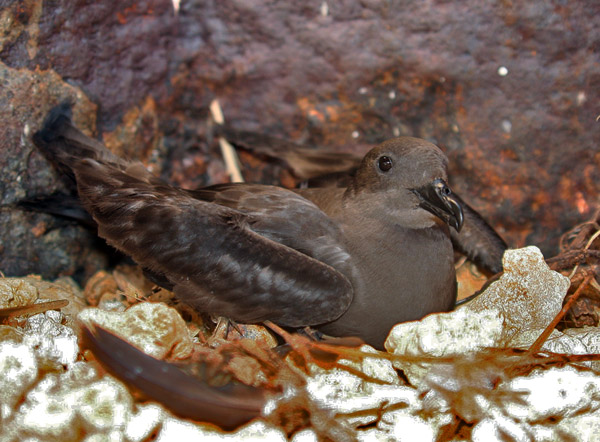| Length: 10 inches | Wingspan: 25 inches | Seasonality: Non-resident in South Dakota |
| ID Keys: Dark brown overall, tail folded to point in flight, pale bars on secondary coverts (flight) | ||
 The
Bulwer's Petrel is medium-sized petrel of semi-tropical locations in both
the Atlantic and Pacific Oceans. Breeding colonies are found in the
North Atlantic on the Azores, Canary, and Cape Verde Islands. Breeding
colonies are much more common in the Pacific, with large breeding
populations on the Hawaiian Islands, as well as southern Japan, southeastern
China, and numerous other semi-tropical islands in the Pacific. Small
breeding populations have also been found in scattered locations such as the
Indian Ocean and in the south Atlantic, suggesting at least some scattered
breeding throughout semi-tropical islands of the world. They are strongly
pelagic, only approaching shore during the breeding season. While many
Bulwer's Petrels can be found near their breeding locations in the Hawaiian
Islands, in North America they are only very rare vagrants, with sightings
off the coast of California, North Carolina, and Virginia.
The
Bulwer's Petrel is medium-sized petrel of semi-tropical locations in both
the Atlantic and Pacific Oceans. Breeding colonies are found in the
North Atlantic on the Azores, Canary, and Cape Verde Islands. Breeding
colonies are much more common in the Pacific, with large breeding
populations on the Hawaiian Islands, as well as southern Japan, southeastern
China, and numerous other semi-tropical islands in the Pacific. Small
breeding populations have also been found in scattered locations such as the
Indian Ocean and in the south Atlantic, suggesting at least some scattered
breeding throughout semi-tropical islands of the world. They are strongly
pelagic, only approaching shore during the breeding season. While many
Bulwer's Petrels can be found near their breeding locations in the Hawaiian
Islands, in North America they are only very rare vagrants, with sightings
off the coast of California, North Carolina, and Virginia.
Habitat: During the breeding season, they are found on largely barren islands, from cliff faces to sandy beaches. Outside of the breeding season, they are highly pelagic, and not often found close to shorelines.
Diet: Feed on small fish and squid, and plankton. They often feed at night on prey items that come to the ocean's surface at that time.
Behavior: They are nocturnal birds around their island breeding colonies, and are likely nocturnal while at sea as well. Foraging is most often done by skimming prey items from the water's surface, but they may also occasionally make very shallow dives. Unlike smaller but similar-looking storm-petrels, Bulwer's Petrels do not engage in foot-pattering behavior. Outside of the breeding season they are usually solitary, rarely seeking out the company of other Bulwer's Petrels.
Nesting: Bulwer's Petrels are colonial nesters, with colonies ranging in size from a handful of breeding pairs to many hundreds. The nest is a cavity, crevice, or at the base or roots of a protective plant. They do not dig their own nesting cavity. Pairs are semi-loyal to each other, with the majority returning to breed with the same partner each season. A single egg is laid, with both parents helping to incubate the egg and tend to the young.
Song: On their breeding grounds, Bulwer's Petrel will give a brusque coq-coq-coq-coq call, with a series of 12-15 notes. They are typically silent away from their breeding colonies.
Migration: Strongly migratory, only found near land during the breeding season. Outside of the breeding season, they can be found throughout tropical and semi-tropical locations in the the Pacific, Atlantic, and Indian Oceans.
Interactive eBird map: Click here to access an interactive eBird map of Bulwer's Petrel sightings
Similar Species: There are a number of sooty or dark-brown species that may be confused with Bulwer's Petrel. Several dark shearwaters may look similar, including Flesh-Footed Shearwater, Short-tailed Shearwater, and Sooty Shearwater, but those are all larger species. For those that have been seen in the North Atlantic (the handful of sightings off the coasts of Virginia and North Carolina), there are no other dark petrel species likely to be found there
Conservation Status: Bulwer's Petrels breeding on scattered island locations across the Atlantic, Pacific and Indian Oceans, and as such, there are no perceived global threats that would affect all breeding sites. Populations are widespread and considered stable. The IUCN lists the Bulwer's Petrel as a species of "least concern".
Further Information: 1) BirdLife.org - Bulwer's Petrel
2) New Zealand Birds Online - Bulwer's Petrel
3) WhatBird.com - Bulwer's Petrel
Photo Information: Photo taken July 8th, 2006 - French Frigate Shoals, Tern Island, Hawaii - Photo taken by "Duncan" - Photo licensed under Creative Commons Attribution 2.0 Generic License
| Click below for a higher-resolution map |
|
|
| South Dakota Status: Non-resident in South Dakota |
Additional Bulwer's Petrel Photos (coming soon!!)
